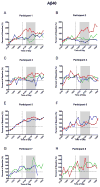Effect of sleep on overnight cerebrospinal fluid amyloid β kinetics
- PMID: 29220873
- PMCID: PMC5876097
- DOI: 10.1002/ana.25117
Effect of sleep on overnight cerebrospinal fluid amyloid β kinetics
Abstract
Sleep disturbances are associated with future risk of Alzheimer disease. Disrupted sleep increases soluble amyloid β, suggesting a mechanism for sleep disturbances to increase Alzheimer disease risk. We tested this response in humans using indwelling lumbar catheters to serially sample cerebrospinal fluid while participants were sleep-deprived, treated with sodium oxybate, or allowed to sleep normally. All participants were infused with 13 C6 -leucine to measure amyloid β kinetics. We found that sleep deprivation increased overnight amyloid β38, amyloid β40, and amyloid β42 levels by 25 to 30% via increased overnight amyloid β production relative to sleeping controls. These findings suggest that disrupted sleep increases Alzheimer disease risk via increased amyloid β production. Ann Neurol 2018;83:197-204.
© 2017 American Neurological Association.
Conflict of interest statement
Brendan P. Lucey, Terry J. Hicks, Jennifer S. McLeland, Cristina D. Toedebusch, Jill Boyd, Jack Baty, John C. Morris: None.
Donald L. Elbert: Dr. Elbert receives royalties from C2N Diagnostics for a patent related to modeling β-amyloid stable isotope labeling kinetics.
Bruce W. Patterson: Dr. Patterson receives royalties from C2N Diagnostics for a patent related to modeling β-amyloid stable isotope labeling kinetics and has provided consultations on β-amyloid peptide turnover kinetics for C2N Diagnostics.
Vitaliy Ovod: Mr. Ovod may receive royalty income based on technology licensed by Washington University to C2N Diagnostics and tied to agreement 010395-0001.
Kwasi G. Mawuenyega: Dr. Mawuenyega may receive royalty income based on a patent of methods for simultaneously measuring the in vivo metabolism of 2 or more isoforms of a biomolecule, licensed by Washington University to C2N Diagnostics.
Randall J. Bateman: Washington University, Dr. Bateman, and Dr. David Holtzman have equity ownership interest in C2N Diagnostics and receive royalty income based on technology (stable isotope labeling kinetics and blood plasma assay) licensed by Washington University to C2N Diagnostics. Dr. Bateman receives income from C2N Diagnostics for serving on the scientific advisory board. Washington University, with Dr. Bateman as co-inventor, has submitted the US nonprovisional patent applications “Methods for Measuring the Metabolism of CNS Derived Biomolecules In Vivo” and provisional patent application “Plasma Based Methods for Detecting CNS Amyloid Deposition.”
Figures



Comment in
-
Reply to "Excess amyloid beta can be degraded in healthy humans".Ann Neurol. 2018 Mar;83(3):650-651. doi: 10.1002/ana.25185. Epub 2018 Mar 3. Ann Neurol. 2018. PMID: 29457845 No abstract available.
-
Excess amyloid beta can be degraded in healthy humans.Ann Neurol. 2018 Mar;83(3):650. doi: 10.1002/ana.25186. Epub 2018 Mar 13. Ann Neurol. 2018. PMID: 29460297 No abstract available.
References
-
- Blackwell T, Yaffe K, Ancoli-Israel S, et al. Poor sleep is associated with impaired cognitive function in older women: the study of osteoporotic fractures. J Gerontol A Biol Sci Med Sci. 2006;61(4):405–10. - PubMed
Publication types
MeSH terms
Substances
Grants and funding
LinkOut - more resources
Full Text Sources
Other Literature Sources

